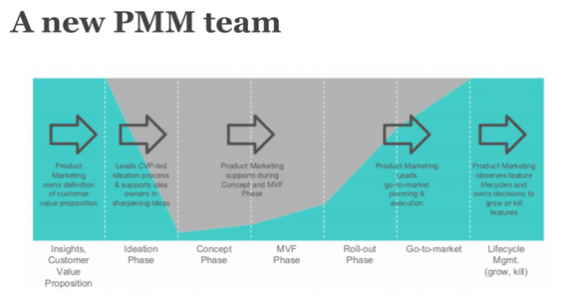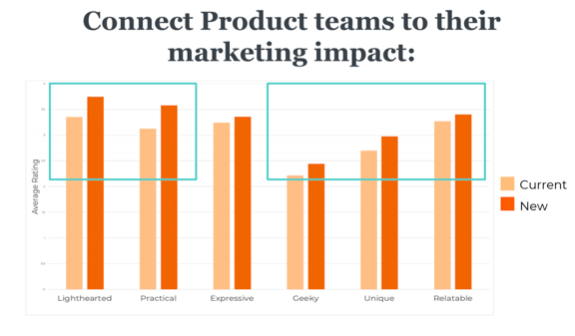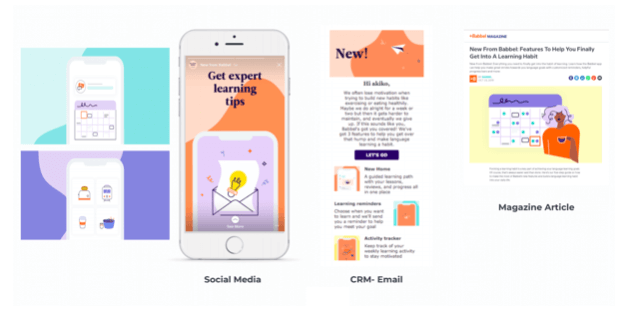I believe product marketing is the chameleon role that sits closely with both product and marketing and provides understanding. When I first joined Babbel, there was a disconnect between the two.
In this article, I’ll share Babbel’s PMM evolution, how we developed a new PMM team, and the key ingredients involved in achieving our goal: bringing the team into the organization to strengthen the beginning and end of the product life cycle.
My name's Belen Caeiro and I'm Director of Product Marketing at Babbel.
In this article, I'll focus on:
- The product marketing evolution at Babbel
- The development of the product marketing team at Babbel
- How product marketing has benefited the company
- Challenges faced during the process
What’s Babbel?
Babbel is a language learning app, we are a subscription business model, available worldwide, and have millions of users.
At Babbel we are self-proclaimed language nerds, we're mainly built by linguists experts. What I mean by that is all our content, our courses, the way our functionality is designed, is made by linguists experts; people that know what you need to really get conversational.
We've learned and understood the number one thing our consumers want, after talking with them over the years, is to really feel understood.
For us, that is something important because, at a moment of ever-increasingly rigid public opinions, we feel languages give you access to different selves, allow you to choose how to make others feel understood, and allow you as well to navigate your own versions.
That, to me, has a lot to do with product marketing. We are a bit of that chameleon role that sometimes sits very close to marketing and can empathize with marketing, and can also sit very close to product and be like, "Yeah, man, these marketers, who can make sense of that?"
We play that role of different selves. If I could define in one word what we bring it would be understanding. You're taking two big parts of an organization; product and marketing, who are almost DNA wise, completely different and you are that understanding middle space.
That's a little bit of what happened at Babbel.
The product marketing evolution at Babbel
Two years ago, we'd been in the industry for about 10 years, growing revenue at two-digit percent numbers year over year, so everything would show you we were doing just fine.
Product and marketing KPIs and effects disconnected
But product and marketing KPIs, indicators, relations were completely disconnected. It was basically like, we produce a sale, talk to the customer up until then, and then we tell you goodbye and best of luck in your language learning journey.
Babbel features not being leveraged to convince the user
We were also not using our product innovation in our brand and marketing campaigns. We were saying the same thing, the same brand promise, the same claim, not using anything of what was new in the product there.
A language learning market with undifferentiated product benefits
The issue here, the cost of opportunity is we were doing that in a market with very undifferentiated product benefits.
In a market where this could have been a low-hanging fruit, where no one was actually making clarity about "This is my saliency", we were also not wanting to use it.
A new PMM team
We decided to build a product marketing team and our main goal for bringing the team into the organization was to strengthen the beginning and the end of the product life cycle.
What we mean by this is, in the beginning, this product marketing team focused on bringing consumer insights and distilling those for the product teams, focusing on bringing competitive intelligence.
And at the very end of the product development lifecycle, as we have an MVP validated, we would be the ones taking that MVP on launch, on growth, and maintaining that feature adoption that gets generated by marketing.
This was the first image I was shown after I was hired and told, "This is where we want to be, off you go."

Key ingredients for set up
One person on that team at that time, and I've been thinking of the three main ingredients that over the last 24 months have got us there.
- The first is to really be a team player.
- Second, own that connection you're building between product and marketing, that translation, that empathy plays where you navigate.
- And the third one, this was something that we discovered this year, make your product team dream.
Play team
Be a team player, it sounds very fluffy. You're probably thinking "I've heard this a million times. What do you mean?".
Identify the unsexy
For us, and I think this is probably similar to many people, whether it's a B2B or B2C company you're in, we come into organizations where that organization has been running already, there's already a product team, there's already a marketing team, chances are some of those 20 hats you might be wearing are already being done by someone.
There's no value in you taking and trying to turf and compete in that area. It is much more valuable for you, as a new expert in that organization but also for the company, to actually choose the topics that are dropped on the floor.
Apply a systematic approach
Those topics that probably might be unsexy for someone that's working right there or maybe complex, and really try to find not just a way of answering them, but a systematic approach for that company to answer them.
For us, as an example, that was running business models and estimations of the impact of new features, new product changes. Our product managers hated Excel and the model so we were like, "Sure, we'll help you with that".
It's not like it's our favorite activity otherwise, but it actually positioned ourselves from a point of expertise within the organization and showed our product and engineering teams we were bringing a toolkit to help their prioritization.
But there's even more than that, showing them there is a way of systematically answering those questions, it doesn't have to be a humongous effort every time you're doing it, builds on your credibility, and starts building your seat at the table on the product development roadmap conversations.
Connect
Connect product teams to their marketing impact
I'm a bit biased here because I came more from the marketing side, but it's really about connecting product teams to the marketing impact they're having.
Normally, you'd have agile teams measuring their work depending on the session they're building, typical metrics a product organization would look into. That's well and fine but for us, it was very important to show them they also were having an impact on revenue generation and brand differentiation.
In this example, for instance, we were redesigning our app registration funnel. We asked the product teams, as we were doing the qualitative research of different MVPs we tested, how these different funnel processes scored in brand attributes.
So not just the messaging and the design, but also the functionality, we would have users go through the different versions, and at the end, ask them about a number of brand attributes.
After four versions, we arrived at an app funnel that actually scored higher in most of our brand attributes. We were able to show our product teams that it actually has value to not only look into the direct impact or short-term impact you're generating with this change.

Not only have I increased monthly active users and the visit to sale of this funnel, but I've built a funnel that actually delivers a more salient product position. People after going through my funnel, have not thought, "Okay, one more language translation app, next" but instead I can connect this specific brand to certain attributes we want to be recognized by.
Dream
The third thing we did started in February of this year, about one year after the team was built.
Make product dream, and show the path
We'd grown from one to three to seven people in the team and we took a moment when we were having some upcoming features in our product, the ones that you see on the left, to walk our product leadership, specifically, through a number of hero product stories for us.
Best in class product story examples that really made them dream, and we showed them this is what your product development could be achieving. This is the level of wowness we could be creating together.
Criteria for marketable feature & product story
You can imagine that after that, we brought a checklist of what is needed to get there, what is needed for their product improvement or new feature to get famous. There are specifics here, but what we really tried to arrive at with them was a standardized way of delivering features we want them to get into a high-impact product campaign.
It can be summarised in four main areas.
1) User-facing value
We need new features or product innovation that actually delivers user-facing value.
You might be amazed that you just refactored all your app code and that's fantastic. But we're not going to tell that to a consumer ever.
2) Reliable launch dates
We need reliable launch dates, I don't know about your side of the house but on our side at least that was a very movable reality.
3) Audience at scale
This is a reality that's very hard to bring home for specifically our engineers, but scale. We have 14 languages and often when we develop a new feature, we launch this in the Indonesian language and we quietly let it happen and see what happens afterward.
Then very slowly, we start taking over the other languages. Maybe we do it in one platform only and see what happens, which is fine and that is what agile development requires and this is why we're able to iterate faster.
But at a moment of a campaign, we need whatever benefit to have reached the majority of our users. It will not be relevant for a marketing campaign if we're not able to talk to the majority of our audience, and potentially a new audience.
4) Frictionless experience
Then for us as well, hopefully, it's not your issue but we needed a frictionless experience. By that, we meant deep links that could take you right to that new feature, ideally, without being logged in, regardless of whether you were coming from a desktop or from an app.
Where did it take us?
This was understood and absorbed and challenged back and really asked if it was that necessary, but at the very end what this brought was our product leadership understood that to create that standardized way of delivering features, we really needed to bring this in alignment with our product organization.
Company OKR3: deliver two high impact product campaigns
What we did in that sense was bring product campaigns as part of the product OKRs for the year, for that specific quarter.
All of a sudden, product teams were seeing in their OKRs, in their company goals, they had to deliver a product marketing campaign.
It became a bit fuzzy at the beginning, like "Hang on a minute, why am I accountable for that? I'm not building the campaign. I'm not the one that is creating the campaign planning or the channel or booking anything of this."
But it was a very effective way to make them understand "No, you have a direct impact on whether that campaign is going to work or not. You keeping that launch day we agreed is going to have a direct impact on whether that campaign is successful. You queueing all the links that you're giving to marketing is going to have a direct impact on whether we will deliver feature adoption, product understanding, or even sales with that campaign".
Cross-functional campaign
That took us also to the most cross-functional campaign that we've delivered over the last two years. This is our latest New from Babbel campaign, if you follow us on Instagram you're going to see some of those designs on the left.

This was a product campaign where product managers ideated with product marketers on the storyline and how we should be telling the key benefits.
Most of our designs you see were done by our product designers who had never done marketing collateral before but were so excited and wanted to be the ones that were delivering the hero creatives of the story.
Ultimately, a campaign that is well delivered in feature adoption. There were three main features in this story; our new home, learning reminders, and an activity tracker, you can see it on that email.
We saw after two weeks of this campaign going live, there had been higher adoption of these specific features, higher usage, not only during the time of the campaign but afterward.
What was hard about it?
This is all well and good but I think it's also fair to tell the full story.
We traded speed for partnership
I've been talking about two years of work and the number one thing we have had to at certain points explain was why we were not going faster. It was also very clear for us we were trading speed for partnership.
That approach of the beginning of being a team player and picking up the unsexy complex tasks that maybe no one is doing but that you know are essential for a better product development process was something that took more time than just appearing and saying, "Hi, I should be doing X".
But we believe it also was one of the main ingredients and the most important things to really build that trust with our product leadership team and really have them understand through actions why we were:
- Contributing to roadmapping,
- Choosing what problem statements to solve from a user perspective,
- Choosing what to prioritize over a quarter.
Reliability by adding value takes more work
The other main point I've also always discussed back with my team is how this approach is more heavy lifting on our end to a certain extent. Building trust and reliability by adding value takes more work.
Again, it's "I'm going to prove to you why I'm here and why I can add value", rather than "Let's discuss ownership and structures from the beginning".
We could have done that but we knew at that time our product organization was going through a number of changes and we were very sure that probably whatever agreement was going to get changed in a matter of six months.
So we chose to support them while they were going through that change and it actually took much more work. For the first year of our team getting ramped up we did much less of marketing activations, marketing campaigns, whether it was to visitors, leads, or subscribers.
We were always clear on that trade-off, it was also something clear we communicated up.
Thank you.


















 Follow us on LinkedIn
Follow us on LinkedIn



.svg?v=3c4c23cd72)